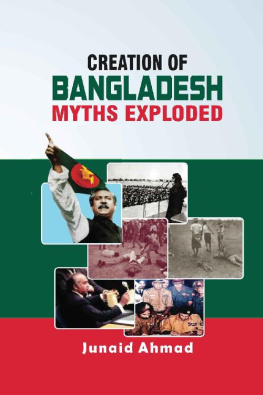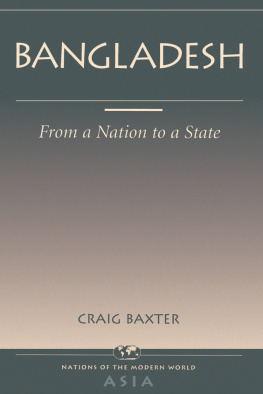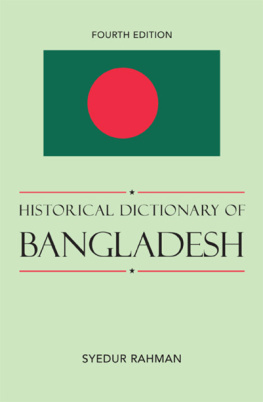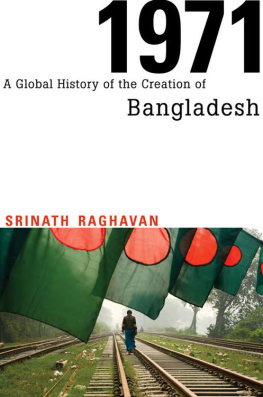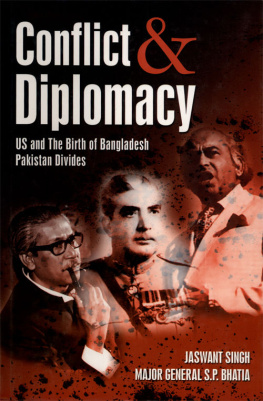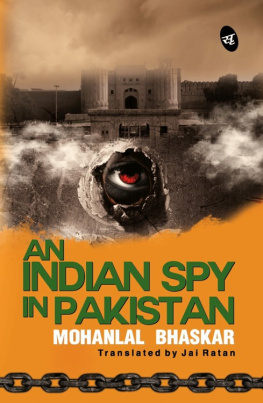CREATION OF BANGLADESH: MYTHS EXPLODED
JUNAID AHMAD
AJA Publishers
NMC Enterprise
First published in Pakistan in 2016 by AJA PublishersNMC Enterprise
Copyright 2016 by Junaid Ahmad
This book is copyright under section 39 of the Pakistans Copyright Ordinance 1962 (XXXIV of 1962) in accordance with sub-rule (3) of Rule 4 of the Copyright Rules, 1967.
No reproduction without permission.
All rights reserved.
The right of Junaid Ahmad to be identified as the author of this work has beenasserted by him in accordance with the above Copyright Ordinance.
1
AJA Publishers
Floor, PIDC House,
M.T. Khan Road, Karachi, PakistanEmail: ajapublishers.nmc@gmail.com www.managementconsultants.pk
The author and publishers have made all reasonable efforts to contact copyright-holders for permission, and apologize for any omissions or errors inthe form of credits given.
Corrections may be made to future printings.
ISBN: 978-969-23169-0-3
Typeset in Garamond 11.5
Printed and bound by Fazlees Book Supermarket in Karachi, Pakistan.
I
would like to dedicate this book to the memory of myfellow countrymen who laid down their lives for thecreation of Pakistan and its unity. Quran says, But donot think of those that have been slain in God's cause as dead. Nay, they are alive! With their Sustainer have they theirsustenance, (AlImran, 3:169).
i
There is no doubt that RAW played a vital role during our liberationwar, but their motive was to divide Pakistan at any cost to weakentheir arch rival [Pakistan]. Their hidden objective is to establishundivided India, which they call Akhand Bharat Mata.
Major General (retd) Z. A. Khan, former Director, DGFI of BangladeshRegular Indian soldiers disguised as the Mukti Bahini have beenfighting the Pakistani Army in East Pakistan from April till December1971 when after losing 5,000 men in covert operations, Indira orderedopen war.
Former Indian Prime Minister Morarji Desai confessing to Oriana Fallac, 1984I would give 100% credit to India for the liberation of Bangladesh.
Deputy Speaker of Bangladesh Parliament, Shawket Ali, 2011Indian soil was made available for training camps, hospitals andsupply depots for the Mukti Bahini of the Bengali resistancemovement India was in fact waging a proxy war against Pakistan.
Archer Blood, American Consul-General to Dhaka, The Cruel Birth of Bangladesh Memoirs of anAmerican Diplomat
In 1971 Indiraji decided to help Sheikh Mujibur Rahman carve outan independent Bangladesh for the Bengalis of East Pakistan wasshe also simultaneously thinking of an operation in West Pakistanaimed to achieve two major objectives, namely to Balkanize WestPakistan, and to liberate Pakistan occupied Kashmir.
L.K. Advani, BJP leader, on his blog in 2010 ii
ACKNOWLEDGEMENTSA
bove all I would like to thank Allah (SWT) who gave me thestrength, courage, inspiration, and means to undertake andcomplete this book.
I am most grateful to my parents who brought me up as a Muslimand a proud Pakistani, having complete faith in Tauheed, love for ourbeloved Prophet (PBUH), and the Two-Nation theory which led tothe creation of Pakistan.
The guidance, support, and advice given by my respectedcolleague Mr Mahboobul Hasan, enabled me to complete thisdaunting task expeditiously and efficiently.
Fellow researchers including Hammal Ikram Kashaney, KhurrumAhmad, and Mir Behroze Noor played an important role in collectingdata, its analysis and preparation of theworking drafts. Admirable staffand secretarial support was provided by Muhammad Aftab, WaseemAhmad, and Syed Zahir. A special thanks is due to Ms Tara Kashif fordoing a great job of editing the text. Her work has made the bookreadable.
JUNAID AHMADAugust, 2016
iii
Bhutto arrived in Dhaka in July 1974. I drove to the airport throughdense crowds lining both sides of the streets resounding withslogans like Bangladesh-Pakistani matre (friendship) Zindabad and Zulfiqar Ali Bhutto Zindabad All the heads of the diplomaticmissions were lined up at the tarmac. Bhutto descended from aspecial Air Force aircraft I was introduced when he reached me inthe reception line. Shaking me by the hand, he turned to Mujibur Rehman and said: So, he represents the country which re-arrangedthe map of the subcontinent in 1971. Then, addressing me, he said: Maybe he (would) help us a second time in re-arranging the map by resolving the Kashmir problem which has been pending for such along time It was the journey back from the airport which was a politically and emotionally disturbing experience for me. As themotorcade moved out, the frenzied enthusiasm of the masses of the people lining the route reached a high pitch, with slogans andshouting in favour of Bhutto and Pakistan I was told later thatpeople threw garlands of shoes on Sheikh Mujibur Rehmans car onhis journey back to the Presidents house. My flag car was vandalizedand the Indian flag tampered with by the crowds Abusive sloganswere shouted against the Indian High Commission and theGovernment of India. I have to confess that I had tears of anger inmy eyes when I returned to my office and sat down to draft mytelegram reporting on the arrival ceremonies.
A passage from the book by former Indian Foreign Secretary, J.N. Dixit, on the first ever visit to Bangladesh by a Pakistani Prime Minister, Zufliqar Ali Bhutto, in July 1974)PROLOGUE
T
he birth of Bangladesh remains as one of the most painfulincident in the seventy-year history of Pakistan. On thefateful day of 16th December 1971 34,000 Pakistani troopssurrendered in Bangladesh giving up the dream of a united Pakistan.It was not only a military failure, but a failure on all fronts by all. Thepoliticians failed to maintain unity among the diversified Pakistanicommunities, the media failed to counter the propaganda campaign ofIndia and her cronies, the diplomats failed to defend and presentPakistans position to the world on the political crisis of 1971, and thedefenders failed to secure our ideological and territorial frontiersagainst internal and external enemies.
Even though, forty-five years have passed, Pakistan, as a nation, isstill haunted by this tragic episode of its dismemberment. Every year the date of 16 th December revives emotions of sorrow, grief, andguilt; and many of us only manage to mourn on our blunders. Greatnations learn from their past, but except bereavement we, as a nation,have not learned from our historical blunders. Our flawed politicaland diplomatic strategies continue to compromise our nationalinterests. Despite the humiliating experience, we continue to stick toineffective and outdated polices and behaviours. This inadequacy hasreincarnated old and given birth to new national, regional, and globalfoes to plot against Pakistans unity, sovereignty, and existence.
Since 1971, sizeable yet casual analysis has emerged and numerous narratives have been written by intellectuals, academicians, militarypersonnel, journalists, diplomats, and politicians from across the world. However, a holistic view and account of the tragedy of 1971seems to be missing. This attempt would endeavour to present a comprehensive and balanced picture of Pakistans dismembermentand creation of Bangladesh. Pakistan was not bifurcatedinstantaneously on 16 th December 1971, rather a series of events leadto its catastrophic division. This book is a humble attempt to trace thehistorical, social, strategic, political, economic, and ideological roots which led to the day of this dissolution of the miracle, called Pakistan.
v
Additionally, several myths have been created, propagated, anddisseminated by India and, at her behest, the Bangladeshigovernment, to defame Pakistan and her institutions. This book has been divided into eight chapters which provide a comprehensive viewof the tragedy of 1971. The chapters are summarized as under:

